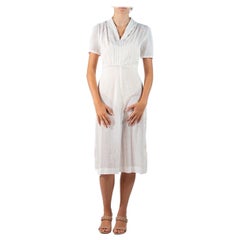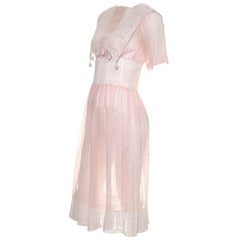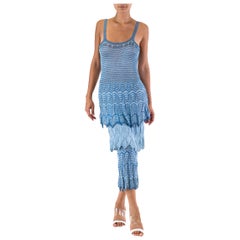1930s Crochet Dress
1930s Casual Dresses
Recent Sales
1930s American Day Dresses
1930s Casual Dresses
Early 20th Century Day Dresses
1930s Maxi Dresses
1930s Day Dresses
1930s American Aesthetic Day Dresses
1930s Evening Gowns
1930s French Aesthetic Day Dresses
1930s American Aesthetic Day Dresses
People Also Browsed
1930s Formal Gowns
1930s French Evening Dresses and Gowns
1930s Formal Gowns
1930s Evening Dresses
1930s American Tea Gowns
1920s Cocktail Dresses
Late 19th Century French Court Gowns
1950s French Evening Dresses and Gowns
1930s French Evening Dresses and Gowns
1920s British Opera Coats
1920s French Aesthetic Evening Dresses
1940s American Cocktail Dresses
1930s Evening Dresses
1930s British Blouses and Tops
1940s Slips
1920s American Formal Wear
Finding the Right Day-dresses for You
Luxurious and versatile, designer day dresses are as well suited to tea at an upscale hotel as they are to your next garden or rooftop party.
Today’s featherlight unisex day dresses — as well as the vibrant vintage day dresses of the 1950s and ’60s — look quite different from the heavy, fabric-rich de rigueur garments of the Victorian era. In the late 19th century, a woman of a certain standing might have multiple dresses to wear throughout the day: specifically, one or two for the daytime and one for the evening. For example, a long-sleeve silk dress with a prominently flared back and a round collar of gold beaded lace that hugs the neck would be suitable for stepping out during the day, while a velvet gown trimmed in silk embroidery but overall comparatively informal in appearance would be worn for afternoon tea at home. At night, a silk velvet evening dress could feature natural world motifs such as butterflies (a characteristic of Art Nouveau design) and have short sleeves adorned with lace and ruffles and a scooped neckline — the perfect attire for the theater.
During the 1920s, after all the chores were done, a woman would change from her housework clothing into a more fashionable day dress to run her errands or socialize. Some 1920s day dresses were brightly colored and featured bold patterns — a cotton dress with a dazzling floral print, perhaps, or, in the case of the more venturesome Art Deco apparel sold in high-end couture fashion boutiques of the era, semi-sheer silk garments embellished with three-dimensional beadwork or rich metallic gold lamé.
Today, a closet full of casual vintage day dresses is a must-have. Whether you opt for black, crimson or beige, day dresses bring an element of glamour to your next appointment, and in the summer, who doesn’t love a wonderfully simple, lightweight day dress cut in cotton and linen?
Because different fashion designers of every decade have offered their own take on the widely loved day dress, you’ll be able to find a variety of vintage and designer day dresses on 1stDibs. Search by creator to find enduring designs by the likes of Emilio Pucci, Pierre Cardin, Yves Saint Laurent and Christian Dior, or browse by period to uncover a scintillating collection of cotton and satin patterned dresses of the 1950s and ’60s.
- 1stDibs ExpertJune 30, 2023What brides wore in the 1930s varied. Some wore long flowing dresses made of satin or silk. Long sleeves were popular and designs often featured only minimal embellishments like appliqués and beading. Because many people faced difficult financial situations due to the Great Depression, brides also sometimes simply wore their best dresses on their wedding days. On 1stDibs, shop a collection of vintage wedding dresses.
- 1stDibs ExpertNovember 26, 2024To identify 1930s furniture, first see if you can spot a maker's mark in hidden areas, such as the back, base, inside of drawers or under tabletops and seats. Trusted online resources can help you determine who produced your furniture based on these markings, and from there, you can research more to get a rough idea of how old your item is. A piece's characteristics can also be helpful when dating furniture. Many items made during the 1930s are examples of Art Deco furniture. Art Deco furniture is characterized by geometric patterns and luxurious materials, such as shagreen, marble, mother of pearl, mirrored glass, exotic animal hides and rare woods like mahogany, ebony and zebra wood. A certified appraiser or experienced antique dealer can provide an expert opinion on when your piece was likely made. On 1stDibs, explore a range of 1930s furniture.
- 1stDibs ExpertMay 5, 2023Yes, people had record players in the 1930s. In fact, record players began to become more common during the decade and continued to grow in popularity throughout the 1940s, 50s and 60s. Thomas Edison made the first phonograph record player in 1877. Shop a variety of record players on 1stDibs.
- 1stDibs ExpertMarch 31, 2023In the 1930s, phones typically looked like rotary telephones. They had either a round or square base with a numbered dial that spun when you dialed and a handset receiver with both an earpiece and a mouthpiece. A cord connected the handset to the base. Find a variety of rotary phones on 1stDibs.
- 1stDibs ExpertApril 5, 2022To tell if a dress is from the 1960s or 1970s, first look for a label. You may be able to determine the approximate date of the dress simply by researching the designer using reputable online sources. Also, check the zippers. Dresses from the 1960s will usually have metal or nylon zippers. Ones from the 1970s are more likely to be plastic. You'll find a large selection of vintage dresses on 1stDibs.
- What is a 1940s style dress?1 Answer1stDibs ExpertOctober 5, 2021The most popular 1940s-style dress was the shirtwaist dress. It had a front opening like a men’s shirt, but with large buttons in the front of the dress, which was practical and easy to wear. The sleeves were short and necklines varied from shirt style to sweetheart and other necklines. Antique and vintage dresses from well-known designers are available on 1stDibs.
- 1stDibs ExpertFebruary 21, 2024The dresses they wore in the 1960s varied depending on the time of day and the occasion. For everyday wear, many women opted for simply tailored frocks called shift dresses. They often featured bold geometric prints in eye-catching colors. In the evening, women tended to opt for gowns with plunging necklines, fitted waists and flowing full skirts. On 1stDibs, shop a diverse assortment of vintage dresses from the 1960s.
- 1stDibs ExpertJune 15, 2023One of the most popular types of dresses during the 1980s was a tight-fitting sheath with oversized shoulder pads. Peplum accents were also common as were large puffy sleeves. On 1stDibs, find a collection of 1980s vintage dresses on 1stDibs.
- What are 1920s dresses called?1 Answer1stDibs ExpertFebruary 13, 2023The iconic dresses from the 1920s are called flapper dresses. This name comes from the term flapper, which was used to describe young women during the period who enjoyed personal fulfillment and independence in American cities, particularly as they gained the right to vote and enjoy other freedoms previously reserved for men. Flappers danced at jazz clubs and upended most societal restrictions placed on women at the time, and fashion statements typically attributed to flappers included short “bob” haircuts, higher hemlines and other then-audacious style choices. Find a selection of flapper dresses on 1stDibs.
- 1stDibs ExpertApril 5, 2024There are a few options for how you should dress for a ’70s party. You can go for the hippie look with dramatic bell-bottoms, fringed jackets and vests and embroidered blouses, or try a sporty look by pairing a vintage tee with high-waisted, button-fly flared jeans and clogs or platform shoes. For a straight-from-the-disco aesthetic, look for surplice and halter dresses decked out in sequins. Men can make a 1970s-inspired statement with a leisure suit or bell-bottoms matched with a turtleneck. Aviator sunglasses are great accessories for both men and women. On 1stDibs, explore a selection of 1970s apparel and accessories.
- 1stDibs ExpertMarch 31, 2023In the 1990s, people dressed in different ways. Styles included grunge, modern preppy, hip-hop and goth. Some trends of the decade were slip dresses, plaid flannel shirts, long plaid skirts, overalls, combat boots and loose-fitting rolled jeans. Neon colors were popular for a time, as were fabric headbands and fabric-covered ponytail holders. Shop a selection of 90s vintage apparel and accessories on 1stDibs.
- 1stDibs ExpertApril 5, 2022In the 1920s, the flapper dress became a fresh new look for both day and evening wear. This shift dress hung from shoulder to just below the knee with a significant drop waistline. The evening versions of these dresses often featured lace, fringe, beadwork and luxe fabrics like chiffon, velvet and taffeta. Shop a collection of expertly vetted vintage flapper dresses from some of the world’s top boutiques on 1stDibs.
- 1stDibs ExpertApril 5, 2022Many different styles of dress were popular in the 1990s, including the slip dress which became very common by the middle of the decade. Tastes and styles varied between regions and among people. On 1stDibs, shop a collection of vintage 1990s dresses from some of the world’s top boutiques.
- 1stDibs ExpertApril 5, 2022A number of dresses were popular during the 1940s. Many women wore short-waist dresses with button necks, collars, fitted waists and full skirts. The classic A-lines with knee-length hems in red, white and blue colors were also a trend. Shop a collection of vintage dresses on 1stDibs.
- 1stDibs ExpertSeptember 27, 2024What the dress style was called in the 1960s varied, as there were several types of dresses that were fashionable during the decade. At the start of the 1960s, many women wore swing dresses featuring fitted bodices and full skirts. Collared, button-up belted dresses called shirtwaist dresses were also popular, as were loose-fitting, flowy shift dresses. By the late 1960s, new styles emerged, such as flared, flowing tent dresses, sleeveless jumpers usually styled over sweaters and blouses and drop-waist dresses, which had their waist seams at the hips rather than the natural waist. Find a variety of 1960s dresses and other vintage dresses on 1stDibs.
- 1stDibs ExpertApril 5, 2022Flapper dresses from the 1920s came in a range of colors, although darker hues such as black and navy were immensely popular. Flapper dresses were cut with straight and slim silhouettes, were typically knee-length and had a lower neckline. They were often made from silk chiffon and featured beaded details. You’ll find a selection of 1920s flapper dresses from some of the world’s top sellers on 1stDibs.
- 1stDibs ExpertFebruary 22, 20211950s-style dresses are often called poodle skirt dresses. The dress is generally a fit-and-flare shape with a wide swing skirt. Another popular type of dress is the form-fitting sheath, also known as a pencil dress.
- 1stDibs ExpertJune 15, 2023In the 1900s, wedding dresses typically looked like full, floor-length garments. Brides wore S-shaped corsets below the usually ruffled bodices, and most designs included large puff sleeves. On 1stDibs, shop a variety of vintage wedding dresses from some of the world's top boutiques.
- 1stDibs ExpertJanuary 27, 2025The designer who became famous with her wrap dresses in the 1970s is Diane von Furstenberg. She debuted her first example in 1974. When creating the Wrap dress, von Furstenberg drew inspiration from the skirts worn by ballerinas. In celebration of the 40th anniversary of the now-iconic dress, an exhibit called Diane von Furstenberg: Journey of a Dress was held at museums in the United States and abroad. On 1stDibs, explore a range of Diane von Furstenberg apparel and accessories.
Read More
Barbra Streisand Channeled Klimt’s ‘Woman in Gold’ in This Shimmering Dress
Costumer to the stars Ray Aghayan brought the famed painting to life with his spectacular design.
A Chanel Obsessive’s Cache Extends Well beyond Her Walk-In Closet
From handbags and heels to jackets and jewels, Sharon Coplan Hurowitz has a deep admiration for (and collection of) all things Chanel.
Behind the 1970s and ’80s Glam of ‘Halston’ with the Hit Show’s Costume Designer
Jeriana San Juan explains how she undertook the intimidating project of designing costumes for the new Netflix series about the New York fashion legend. (Hint: She found vintage Halston on 1stDibs!)
A Short History of Capri Pants, on the 100th Birthday of Their Inventor
Once considered a controversial item of clothing, fashion designer Sonja de Lennart's creation is now a bona fide classic.
How the Chanel Jacket Forever Changed What Women Wear
The classic tweed garment has been a wardrobe staple of chic women around the world since the 1950s.
A Pair of Shoes — Heels or Flats — Can Tell an Impactful Story
Amanda Benchley and Bridget Moynahan teamed up to explore the relationship between powerful women and their most significant footwear.
You Saw It at the Met Ball. Here’s What Camp Fashion Is Really About
This year's Costume Institute exhibition is all about embracing the eccentric.
The V&A Takes a Fresh Look at the New Look’s Pioneering Progenitor, Christian Dior
Ballrooms, Bar Suits and British royals — in a sweeping exhibition, the London museum looks back on 70 years of the French fashion house, as well as its illustrious founder and his fondness for the United Kingdom.


